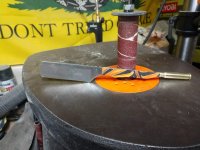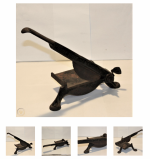This is much heavier than I expected for the price. I was looking for a knife to dedicate to vegetable slicing. It works well on a plug....so far. And mine came razor sharp.
Cutting European Plugs into Proper Flakes
- Thread starter Terry Lennox
- Start date
You are using an out of date browser. It may not display this or other websites correctly.
You should upgrade or use an alternative browser.
You should upgrade or use an alternative browser.
SmokingPipes.com Updates
Watch for Updates Twice a Week
Aged gouda?With most cheese slicers you can tilt to slice thicker, but you could be right.
Cheese can also be dense, but you could be right
View attachment 118171
Last edited:
An acquaintance was making his own tampers with bullet casings and also makes straight razors. He decided to combine the two (see picture below).
I thought it would be great for plugs. It's just a little larger than I expected (and I was hoping the blade would fold into the handle).
I still think it's a neat homemade tool.
I thought it would be great for plugs. It's just a little larger than I expected (and I was hoping the blade would fold into the handle).
I still think it's a neat homemade tool.
Attachments
I want the block and the machine
Yes at least 30 months, there also 4 year old ones. I love the taste and the gritty texture, but eating it would put me straight into my sodium red zone for the coming days, days after eating it I feel dehydrated.Aged gouda?I love the taste but I don't like the crystals.
When I haven't had a knife and cutting board handy, I've used a cigar cutter to nip corners off a plug; not ideal, but works in a pinch.
Nice. A lot of great options being shared here.This is much heavier than I expected for the price. I was looking for a knife to dedicate to vegetable slicing. It works well on a plug....so far. And mine came razor sharp.
I use a kitchen knife, chef style, made of softer steel that would not chip and long enough to provide leverage.
Cast iron rope cutters were made by the millions and could be found in every general store in the country for a century.I want the block and the machine
As a result, they are easy to find (and relatively inexpensive) in today's roadside antique shops.
The catch? They were NOT designed to slice flakes from plug. They must be modified to do that. And that has a catch: They are riveted together, not screwed; and their blades are too thin & flexy for slicing. Modifying one to perform as seen in those pics involves a lot more work than anyone who hasn't tried it would believe.
Sounds like work! Yet it looks super coolCast iron rope cutters were made by the millions and could be found in every general store in the country for a century.
As a result, they are easy to find (and relatively inexpensive) in today's roadside antique shops.
The catch? They were NOT designed to slice flakes from plug. They must be modified to do that. And that has a catch: They are riveted together, not screwed; and their blades are too thin & flexy for slicing. Modifying one to perform as seen in those pics involves a lot more work than anyone who hasn't tried it would believe.
Definitely yes to both.Sounds like work! Yet it looks super cool
Knowing what I know now, I wouldn't take on such a project again.
But the resulting machine amazed even Mike McNiel---who pronounced it "cooler than shit" at a KC club meeting a while back---so I'm glad to have it.

Lovely island music! Although he doesn't sound like he's from the same island as the music. He has an interesting fill technique.Here is the James Fox video on slicing plugs. Note the Warrior Plug package in the foreground - sadly this blend is no longer made.
Ernie Q. mentioned how hard it was to slice flakes for customers with such a tool. As I never operated one, your insight is very meaningful regarding it's limitations. Would you, please, show a picture of the tool you designed? It might be inspirational for us, the 'home slicers'.Cast iron rope cutters were made by the millions and could be found in every general store in the country for a century.
As a result, they are easy to find (and relatively inexpensive) in today's roadside antique shops.
The catch? They were NOT designed to slice flakes from plug. They must be modified to do that. And that has a catch: They are riveted together, not screwed; and their blades are too thin & flexy for slicing. Modifying one to perform as seen in those pics involves a lot more work than anyone who hasn't tried it would believe.
Sorry, just saw the attachments now. Are the screws on top meant for extra stability and strengthening of the blade ? Also, what type of steel would you consider suitable for the job?Ernie Q. mentioned how hard it was to slice flakes for customers with such a tool. As I never operated one, your insight is very meaningful regarding it's limitations. Would you, please, show a picture of the tool you designed? It might be inspirational for us, the 'home slicers'.
I'm not sure what you're asking.Ernie Q. mentioned how hard it was to slice flakes for customers with such a tool. As I never operated one, your insight is very meaningful regarding it's limitations. Would you, please, show a picture of the tool you designed? It might be inspirational for us, the 'home slicers'.
I didn't design anything, just modified a commonly-found-in-antique-stores "rope cutter" to slice plugs well.
The changes & enhancements are hard to see (except for the 3X thicker stainless blade), plus are mostly internal.
Sorry, just saw the attachments now. Are the screws on top meant for extra stability and strengthening of the blade ? Also, what type of steel would you consider suitable for the job?
The original blade for those choppers is surprisingly thin & flexible, because they were disposable by design. It kept stores from having to sharpen them.
The entire interior of the machine was designed around that exact thickness, though. Meaning altering it to accept/fit a thicker blade require grinding cast iron. Not recommended. lol
Ditto disassembling something that's been riveted and staked together. It can be done, but definitely requires, um... committment. lol
You're better off finding a machine that was designed for the task of slicing---as opposed to chopping---in the first place.
Like so:
Attachments
George, I recall you mentioning the Knife taper......... was it a single edge worked best? (Sharpened on one side only), or was it a conventional edge worked best? (Both sides of the knife sharpened)........The changes & enhancements are hard to see (except for the 3X thicker stainless blade), plus are mostly internal.









